Hierarchical Structure and Organizational Model of County Tourism Network of the Tibetan Plateau
Abstract
:1. Introduction
2. Materials and Methods
2.1. Study Area
2.2. Data Source
2.3. Research Methods
2.3.1. Tourism Gravity Model
2.3.2. Social Network Analysis
2.3.3. Dominant Flow
3. Results
3.1. Hierarchical Structure of Tourism Network on the Tibetan Plateau
3.1.1. County Tourism Nodes
3.1.2. Inter-County Tourism Links
3.2. Organizational Model of Tourism Network on the Tibetan Plateau
3.2.1. Dominant Flow
3.2.2. Community Structure
4. Discussion
4.1. Theoretical Implications
4.2. Practical Implications
5. Conclusions
- Overall characteristics of the county tourism network: ① It showed the unbalanced characteristics of decreasing from the east to the west, Xichang 2, Dayi 3, Shifang 2, Mianzhu 2, Shangri-La 2, and other core growth poles initially formed. ② The Chengguan 1 (Lhasa), Pengzhou 2, and Golmud2 had a major impact on the dynamics of the whole network. ③ According to the capacity of tourism organizations, county tourism nodes formed four types, showing spatial polarization characteristics and noticeable zonal distribution differences. ④ The cohesion of the network needs to be improved, and the multidimensional system structure of county tourism nodes has been formed.
- Structural characteristics of inter-county tourism linkages: ① In line with the law of distance decay, the travel demand within a radius of 200 km was prominent, showing significant spatial proximity characteristics. ② The hierarchical spatial structure of “inter-county” tourism links was distinct, with the distribution characteristics of “dense in the east and sparse in the west”. The denser the cross-regional links, the more pronounced the trend of forming a network and consolidating and strengthening the linkage pattern.
- The county tourism network had more distinctive characteristics of dominant flow and community structure, forming an orderly system of hierarchical connections and four regional functional groups.
Author Contributions
Funding
Institutional Review Board Statement
Informed Consent Statement
Data Availability Statement
Conflicts of Interest
References
- Ke, W.; Chen, W.; Yang, Q. Uncovering spatial organization patterns of regional city networks from express way traffic flow data: A case study of Jiangsu province, China. Geogr. Res. 2018, 37, 1832–1847. [Google Scholar] [CrossRef]
- Kim, Y.R.; Scott, N. Network dynamics of tourism development in South Korea. Curr. Issues Tour. 2018, 21, 1239–1259. [Google Scholar] [CrossRef] [Green Version]
- Jesus, C.; Franco, M. Cooperation networks in tourism: A study of hotels and rural tourism establishments in an inland region of Portugal. J. Hosp. Tour. Manag. 2016, 29, 165–175. [Google Scholar] [CrossRef]
- Erkuş-Öztürk, H.; Eraydın, A. Environmental governance for sustainable tourism development: Collaborative networks and organisation building in the Antalya tourism region. Tour. Manag. 2010, 31, 113–124. [Google Scholar] [CrossRef]
- Cawley, M.; Marsat, J.; Gillmor, D. Promoting integrated rural tourism: Comparative perspectives on institutional networking in France and Ireland. Tour. Geogr. 2007, 9, 405–420. [Google Scholar] [CrossRef]
- van der Zee, E.; Vanneste, D. Tourism networks unravelled; a review of the literature on networks in tourism management studies. Tour. Manag. Perspect. 2015, 15, 46–56. [Google Scholar] [CrossRef] [Green Version]
- Yin, P.; Lin, Z.; Prideaux, B. The impact of high-speed railway on tourism spatial structures between two adjoining metropolitan cities in China: Beijing and Tianjin. J. Transp. Geogr. 2019, 80, 102495. [Google Scholar] [CrossRef]
- Noguiera, S.; Pinho, J.C. Stakeholder network integrated analysis: The specific case of rural tourism in the Portugese Peneda-Geres National Park. Int. J. Tour. Res. 2015, 17, 325–336. [Google Scholar] [CrossRef] [Green Version]
- Pavlovich, K. The evolution and transformation of a tourism destination network: The Waitomo Caves, New Zealand. Tour. Manag. 2003, 24, 203–216. [Google Scholar] [CrossRef]
- Timur, S.; Getz, D. A network perspective on managing stakeholders for sustainable urban tourism. Int. J. Contemp. Hosp. Manag. 2008, 20, 445–461. [Google Scholar] [CrossRef]
- Zhong, S.; Zhang, J.; Han, G.; Wang, L.; Zhang, H. Spatial patterns of tourist flow: Problems and prospects. Hum. Geogr. 2010, 25, 31–36. [Google Scholar] [CrossRef]
- Peng, H.; Lu, L.; Lu, X.; Liu, S. Spatial network structure and optimization of cross-border tourism area based on tourist flow: A case study in Lugu Lake. Prog. Geogr. 2014, 33, 422–431. [Google Scholar] [CrossRef]
- Liu, F.; Zhang, J.; Chen, D. The process and spatial-temporal feature of tourism destination network Evolution: A case study of MT. Huangshan Scenic Area and Tangkou. Sci. Geogr. Sin. 2014, 34, 1428–1437. [Google Scholar] [CrossRef]
- Gao, P.; Xi, J. Research on the spatial structure and complex characteristics of tourism destination network-A case study of Yesanpo tourism destination. J. Nat. Resour. 2018, 33, 85–98. [Google Scholar] [CrossRef]
- Wu, Z.; Zhang, L.; Huang, S. Spatial structure and characteristics of tourism economic connections in Guangdong-Hong Kong-Macao Greater Bay Area. Geogr. Res. 2020, 39, 1370–1385. [Google Scholar] [CrossRef]
- Chen, H.; Lu, L.; Zheng, S. The spatial network structure of the tourism destinations in urban agglomerations based on tourist flow: A case study of the Pearl River Delta. Acta Geogr. Sin. 2011, 66, 257–266. [Google Scholar] [CrossRef]
- Yu, H.; Chen, T.; Lu, L.; Wang, K.; Zhu, D. Structure of tourist economy network and its spatial development pattern in Jianghuai urban agglomeration. Prog. Geogr. 2014, 33, 169–180. [Google Scholar] [CrossRef]
- Zheng, B.; Liu, A.; Han, J.; Ming, Q.; Zhang, X. The structural evolution of Yunnan tourism economic contact network and the construction of cooperative development model. Econ. Geogr. 2021, 41, 222–231. [Google Scholar] [CrossRef]
- Wang, Z.; Liu, Q. The evolution and influencing factors of spatial network structure of China’s provincial tourism efficiency. Sci. Geogr. Sin. 2021, 41, 397–406. [Google Scholar] [CrossRef]
- Wang, Y.; Ma, Y.; Qang, M. Network structure of multicity inbound tourists to China. Prog. Geogr. 2012, 31, 518–526. [Google Scholar] [CrossRef]
- Morrison, A.; Lynch, P.; Johns, N. International Tourism Networks. J. Contemp. Hosp. Manag. 2004, 16, 197–202. [Google Scholar] [CrossRef]
- Éber, F.Z.; Baggio, R.; Fuchs, M. Hyperlink network analysis of a multi destination region: The case of Halland, South Sweden. Inf. Technol. Tour. 2018, 20, 181–188. [Google Scholar] [CrossRef] [Green Version]
- Tao, W. Spatial-Temporal evolution of tourism economic network structure and its development mode in Wuling Mountainous Area of Hunan at the county level. Econ. Geogr. 2020, 40, 211–220. [Google Scholar] [CrossRef]
- Miao, H.; Zeng, B. Analysis on inter-county economic linkage in Hohhot-Baotou-Ordos-Yulin Urban Agglomeration and its temporal-spatial evolution. Financ. Theory Teach. 2020, 6, 76–84. [Google Scholar] [CrossRef]
- Kang, S.; Lee, G.; Kim, J. Identifying the spatial structure of the tourist attraction system in South Korea using GIS and network analysis: An application of anchor-point theory. J. Destin. Mark. Manag. 2018, 9, 358–370. [Google Scholar] [CrossRef]
- María, S.G.; Francisco, J.; Ledesma, R. International trade and tourism flows: An extension of the gravity model. Econ. Model. 2015, 52, 1026–1033. [Google Scholar] [CrossRef]
- Zhou, H.; Wang, F. Research on structure characteristics of the inter-provincial tourist flow spatial network in China based on the modified gravity model. Geogr. Res. 2020, 39, 669–681. [Google Scholar] [CrossRef]
- Shih, H.-Y. Network characteristics of drive tourism destinations: An application of network analysis in tourism. Tour. Manag. 2006, 27, 1029–1039. [Google Scholar] [CrossRef]
- Scott, N.; Baggio, R.; Cooper, C. Network Analysis and Tourism: From Theory to Practice; Channel View Publications: New York, NY, USA, 2008; p. 222. [Google Scholar]
- Liu, F.; Zhang, J.; Zhang, J.; Chen, D. Relationships and networks in tourism destination research: A review of tourism research under the perspective of social network theory at home and abroad. Tour. Sci. 2016, 30, 1–14 + 78. [Google Scholar] [CrossRef]
- Zipf, G.K. The P1 P2/D hypothesis: On the intercity movement of persons. Am. Sociol. Rev. 1946, 11, 677–686. [Google Scholar] [CrossRef]
- Haugland, S.A.; Ness, H.; Gronseth, B.O.; Aarstad, J. Development of tourism destinations: An integrated multilevel perspective. Ann. Tour. Res. 2011, 38, 268–290. [Google Scholar] [CrossRef]
- Asero, V.; Gozzo, S.; Tomaselli, V. Building tourism networks through tourist mobility. J. Travel Res. 2015, 55, 751–763. [Google Scholar] [CrossRef]
- Mou, N.; Zheng, Y.; Makkonen, T.; Yang, T.; Tang, J.; Song, Y. Tourists’ digital footprint: The spatial patterns of tourist flows in Qingdao, China. Tour. Manag. 2020, 81, 104151. [Google Scholar] [CrossRef]
- Gan, C.; Voda, M.; Wang, K.; Chen, L.; Ye, J. Spatial network structure of the tourism economy in urban agglomeration: A social network analysis. J. Hosp. Tour. Manag. 2021, 47, 124–133. [Google Scholar] [CrossRef]
- Chen, J.S. A case study of Korean outbound travelers’ destination images by using correspondence analysis. Tour. Manag. 2001, 22, 345–350. [Google Scholar] [CrossRef]
- Ritchie, R.J.B.; Ritchie, J.R.B. A framework for an industry supported destination marketing information system. Tour. Manag. 2002, 23, 439–454. [Google Scholar] [CrossRef]
- Yvonne, V.F.; Evert, G. Hotel networks and social capital in destination marketing. Int. J. Serv. Ind. Manag. 2006, 17, 58–75. [Google Scholar] [CrossRef]
- Zhou, Y.; Wei, X.; Liang, F. Tourism destination image integrated marketing communications: A composite IPA research based on ancient water towns in the southern Yangtze River case. Tour. Trib. 2013, 28, 53–60. [Google Scholar] [CrossRef]
- Ji, Z.; Jiang, Y.; Xie, T. The perceptions and attitudes of residents towards the impacts of tourism. Resour. Sci. 2017, 39, 396–407. [Google Scholar] [CrossRef] [Green Version]
- Shi, C.; Zhang, J.; Shen, Z.; Yang, Y.; Zhong, J. An overview of quantitive evaluation of the tourist destination competitiveness. Hum. Geogr. 2006, 3, 72–77. [Google Scholar] [CrossRef]
- Yang, X.; Lu, L. Retrospect and prospect of study on resort life cycle. Hum. Geogr. 2004, 19, 5–10. [Google Scholar] [CrossRef]
- Zhang, J.; Sun, G. Life cycle and upgrade of Shanxi’s mansion as a tourist destination: Taking Qiao’s Grand Compound as example. Geogr. Res. 2012, 31, 2104–2114. [Google Scholar]
- Garay, L.; Canoves, G. Life cycles, stages and tourism history: The Catalonia (Spain) Experience. Ann. Tour. Res. 2011, 38, 651–671. [Google Scholar] [CrossRef]
- Aquino, R.S.; Lück, M.; Schänzel, H.A. A conceptual framework of tourism social entrepreneurship for sustainable community development. J. Hosp. Tour. Manag. 2018, 37, 23–32. [Google Scholar] [CrossRef]
- Ma, Y.; Zhang, X. A research review of tourist destination in China. World Reg. Stud. 2008, 144–153 + 173. [Google Scholar] [CrossRef]
- Baggio, R. Tourism destinations: A universality conjecture based on network science. Ann. Tour. Res. 2020, 82, 102929. [Google Scholar] [CrossRef]
- Marrocu, E.; Paci, R. Different tourists to different destinations: Evidence from spatial interaction models. Tour. Manag. 2013, 39, 71–83. [Google Scholar] [CrossRef] [Green Version]
- Wang, Z.; Liang, L.; Chu, X.; Li, J. Examining the coordination effect and interactive stress between tourism economy and ecoenvironment in the Tibetan Plateau. J. Geo-Inf. Sci. 2019, 21, 1352–1366. [Google Scholar] [CrossRef]
- Yu, Z.; Sun, G.; Feng, Q.; Luo, Z. Tourism climate comfort and risk for the Tibetan Plateau. Resour. Sci. 2014, 36, 2327–2336. [Google Scholar]
- Zhang, R.; Xi, J.; Yao, Y.; Ge, Q. Evaluation of tourism dynamic landscape along Qinghai-Tibet railway based on the visual corridor. Acta Ecol. Sin. 2014, 34, 3320–3330. [Google Scholar] [CrossRef]
- Jiang, G.; Zhuo, M. Environment carrying capacity of eco-tourism at county levels in the south of the Tibetan Plateau. J. Arid. Land Resour. Environ. 2014, 28, 202–208. [Google Scholar] [CrossRef]
- Xi, J.; Zhang, R.; Zhao, M. Travel risk evaluation along the Qinghai-Tibet Railway. J. Mt. Sci. 2012, 30, 737–746. [Google Scholar] [CrossRef]
- Chen, X.; Wang, T.; Zheng, X.; Han, F.; Yang, Z. The structure and evolution of the tourism economic network of the Tibetan Plateau and its driving factors. Land 2022, 11, 241. [Google Scholar] [CrossRef]
- Zhu, D.; Yu, H.; Liu, Q.; Liu, L. Network structure characteristics and organizational models of tourist flow to Tibet: Comparative analysis based on group and self-guided tours. Prog. Geogr. 2021, 40, 812–824. [Google Scholar] [CrossRef]
- Chen, R.; Wang, X.; Zhou, Q.; Zhang, Z. The eco-tourism spatial structure in Tibetan Plateau. J. Arid. Land Resour. Environ. 2012, 26, 192–198. [Google Scholar] [CrossRef]
- Zhang, Y.; Li, B.; Liu, L.; Zheng, D. Redetermine the region and boundaries of Tibetan Plateau. Geogr. Res. 2021, 40, 1543–1553. [Google Scholar] [CrossRef]
- Crampon, L.J. A New Technique to Analyze Tourist Markets. J. Mark. 1966, 30, 27–31. [Google Scholar] [CrossRef]
- Shi, Q.; Xie, Y.; Han, Z.; Liu, T.; Liu, G.; Du, P. Spatial structure and spatial development patterns of urban tourism economic connections in northeast China. Econ. Geogr. 2018, 38, 211–219. [Google Scholar] [CrossRef]
- Miguéns, J.I.L.; Mendesb, J.F.F. Travel and tourism: Into a complex network. Phys. A Stat. Mech. Its Appl. 2008, 387, 2963–2971. [Google Scholar] [CrossRef] [Green Version]
- Dredge, D. Policy networks and local organization of tourism. Tour. Manag. 2006, 27, 269–280. [Google Scholar] [CrossRef]
- Scott, N.; Cooper, C.; Baggio, R. Destination networks-four Australian cases. Ann. Tour. Res. 2008, 35, 169–188. [Google Scholar] [CrossRef]
- Zhou, H.; Xu, C. Research on structural characteristics of spatial network for Hunan’s tourism economy. Theory Pract. Financ. Econ. 2015, 36, 126–131. [Google Scholar] [CrossRef]
- Dai, T.; Jin, F.; Wang, J. Spatial interaction and network structure evolvement of cities in term of China’s railway passenger flow in 1990s. Prog. Geogr. 2005, 24, 80–89. [Google Scholar] [CrossRef]
- Wang, J.; Jing, Y. Comparison of spatial structure and organization mode of inter-city networks from the perspective of railway and air passenger flow. Acta Geogr. Sin. 2017, 72, 1508–1519. [Google Scholar] [CrossRef]
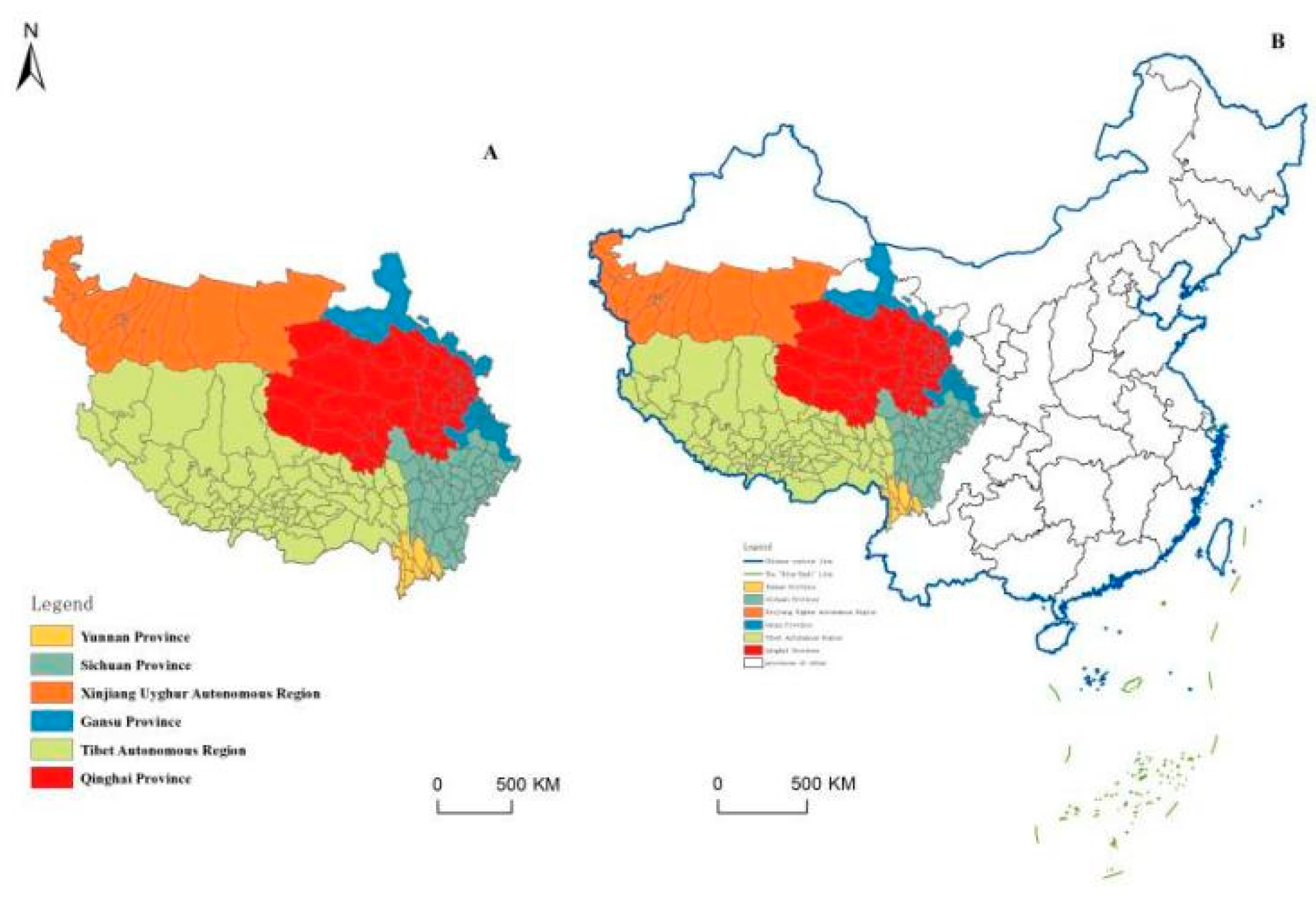
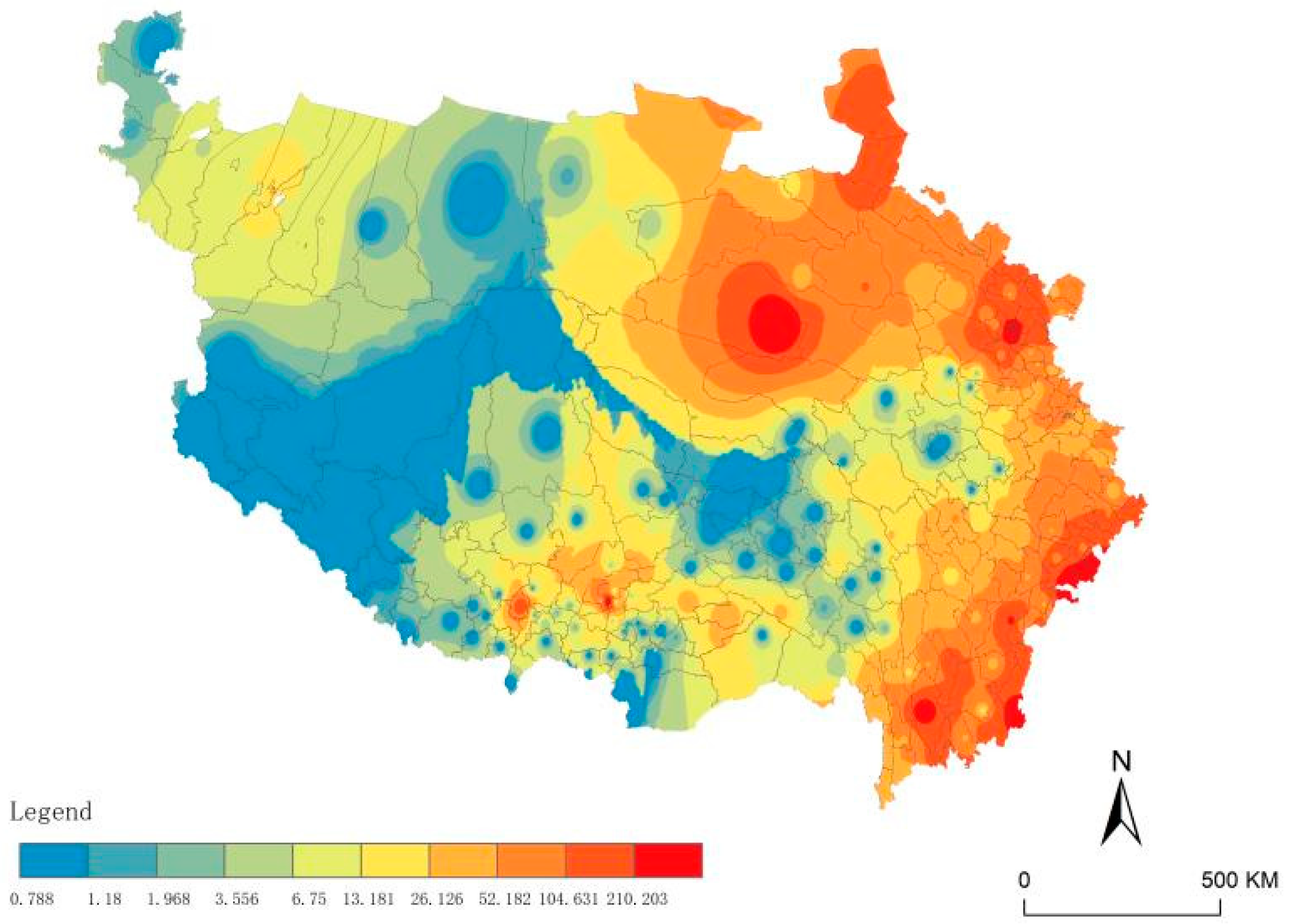
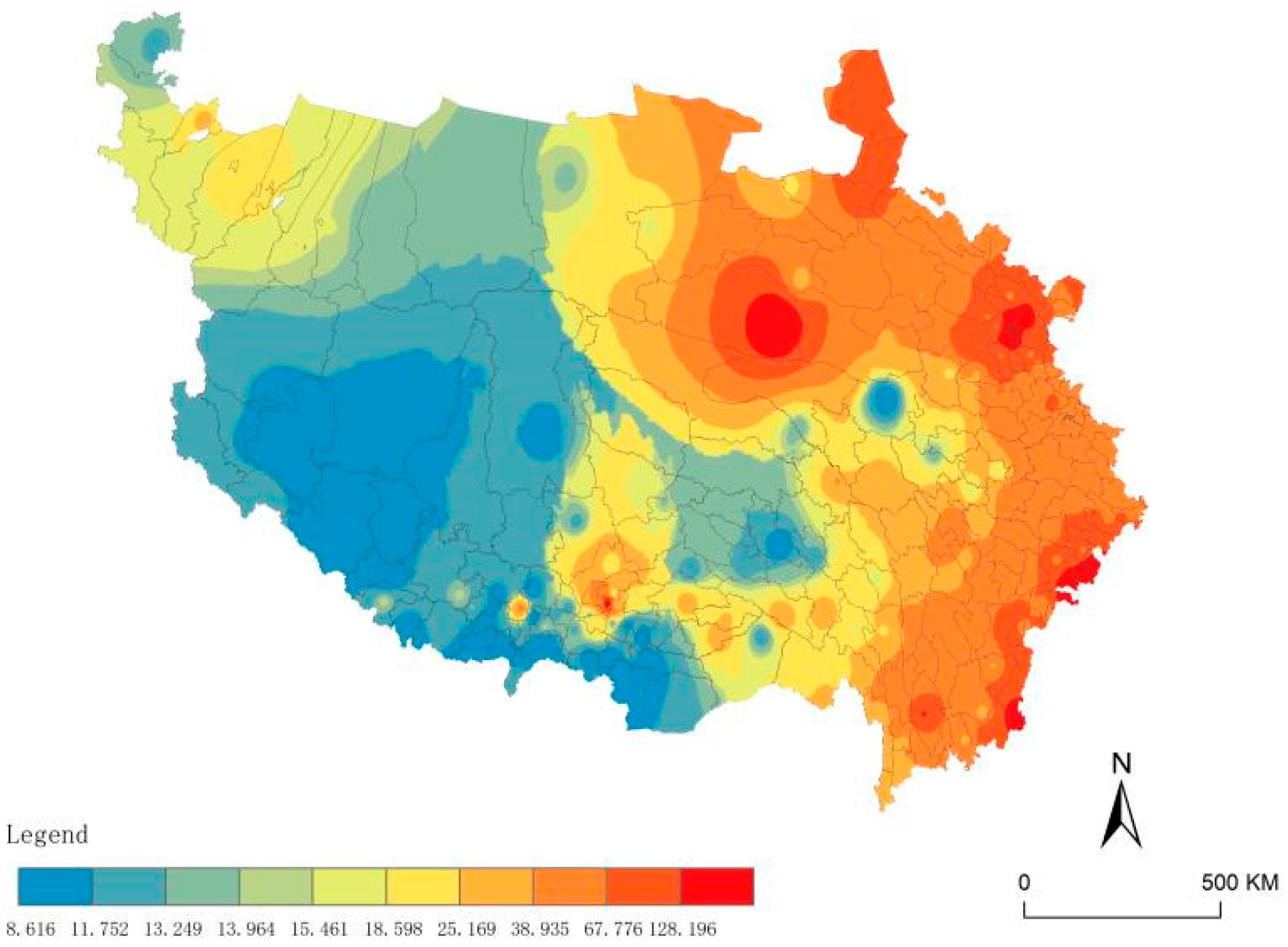
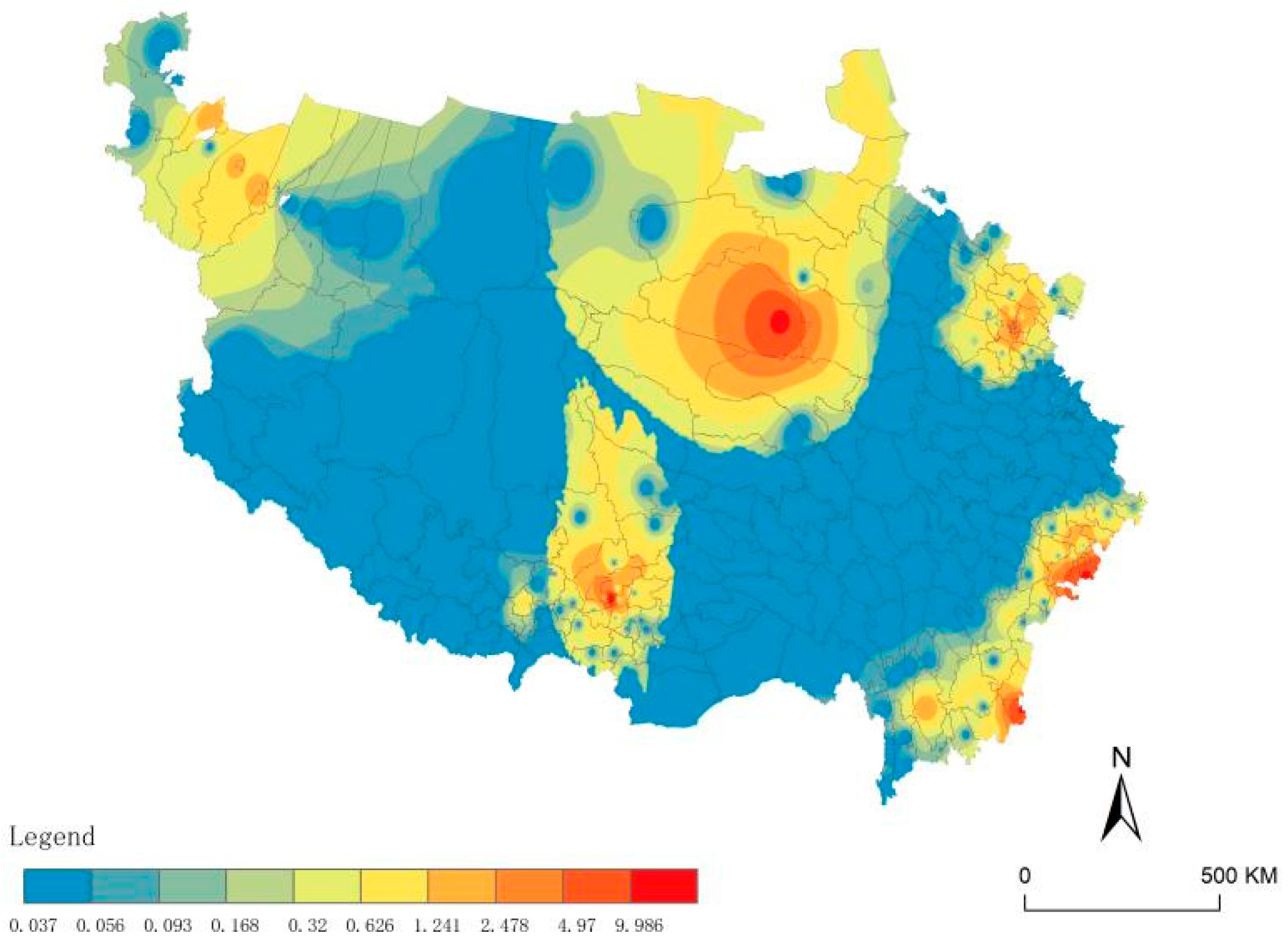
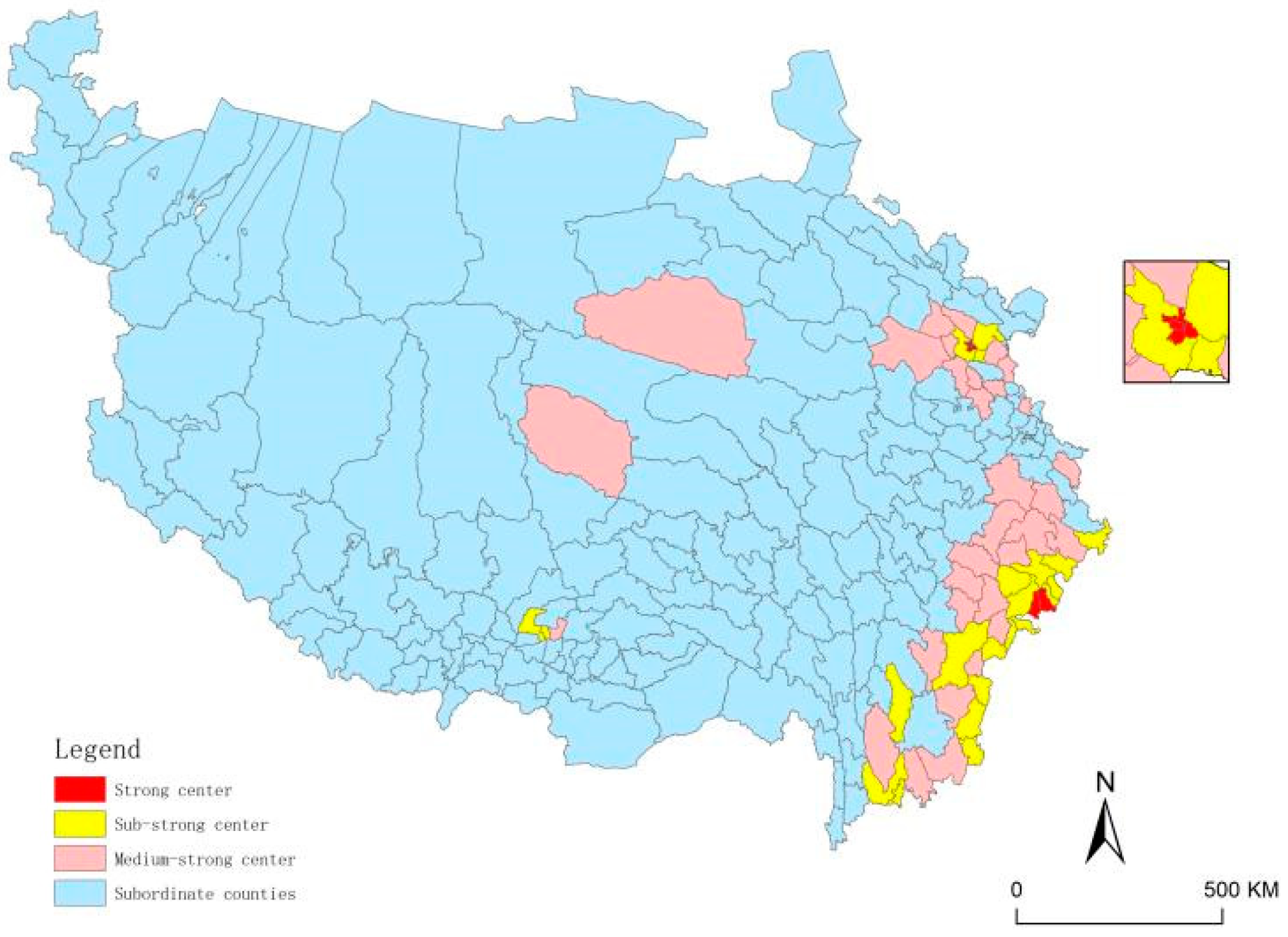

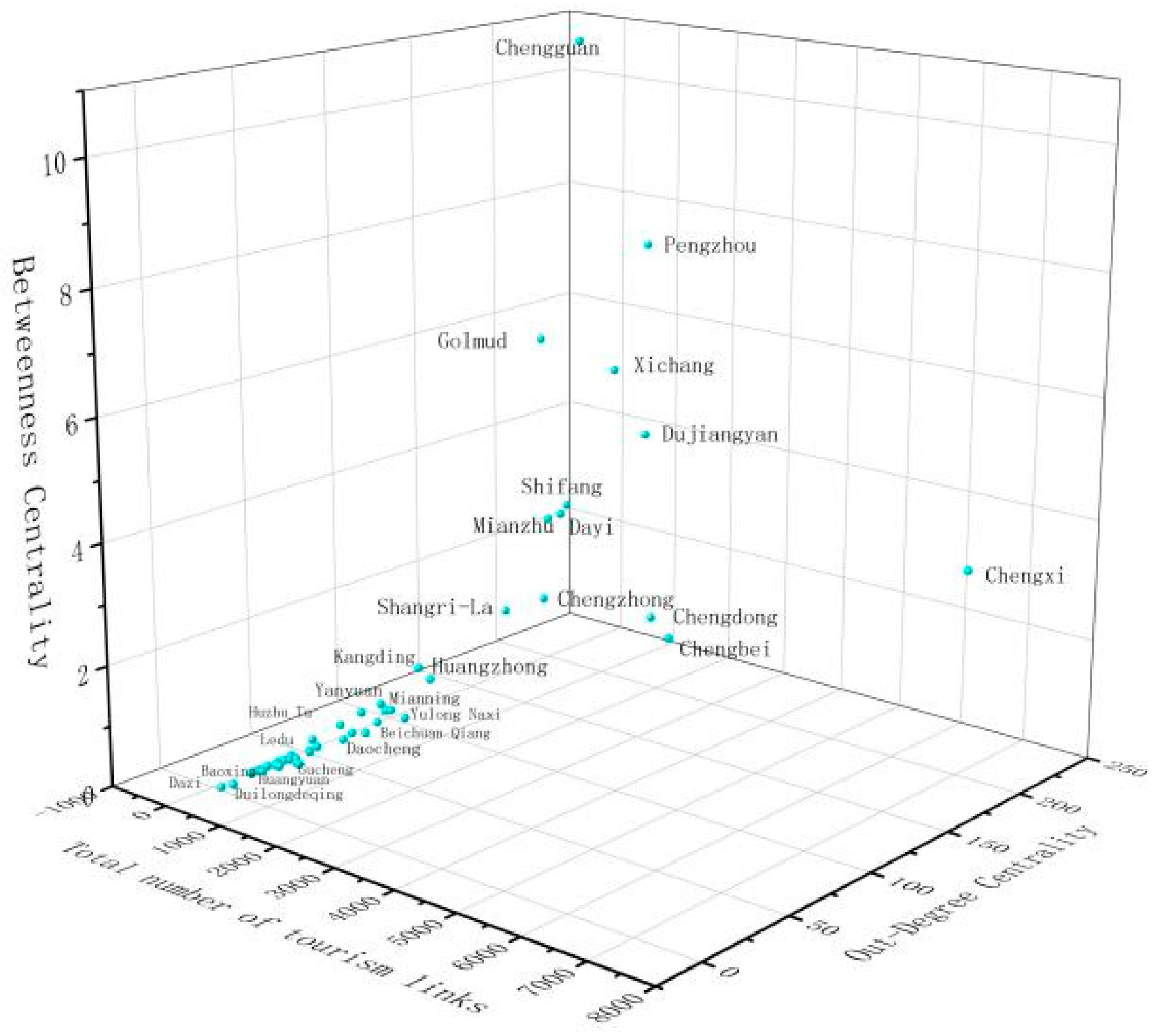

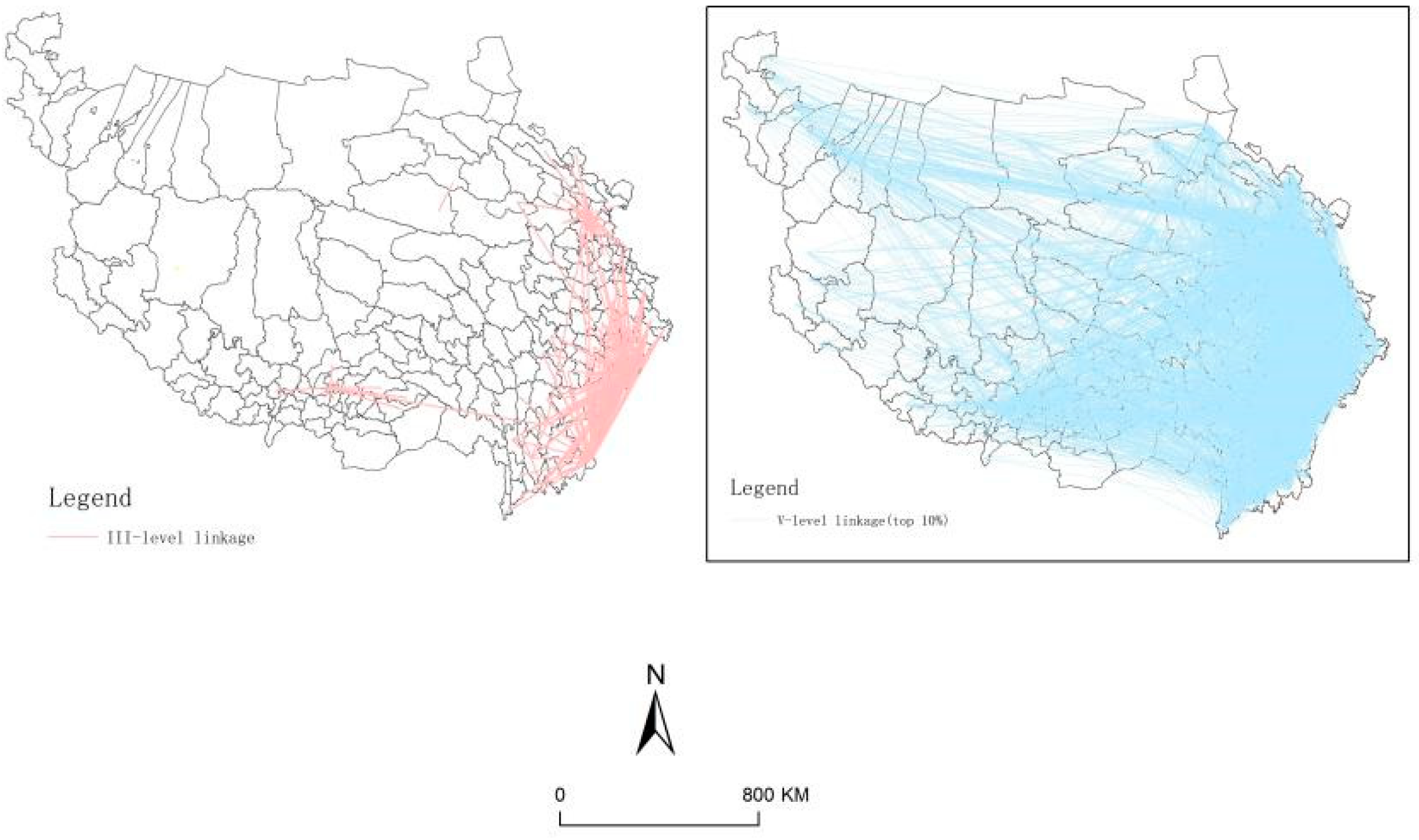

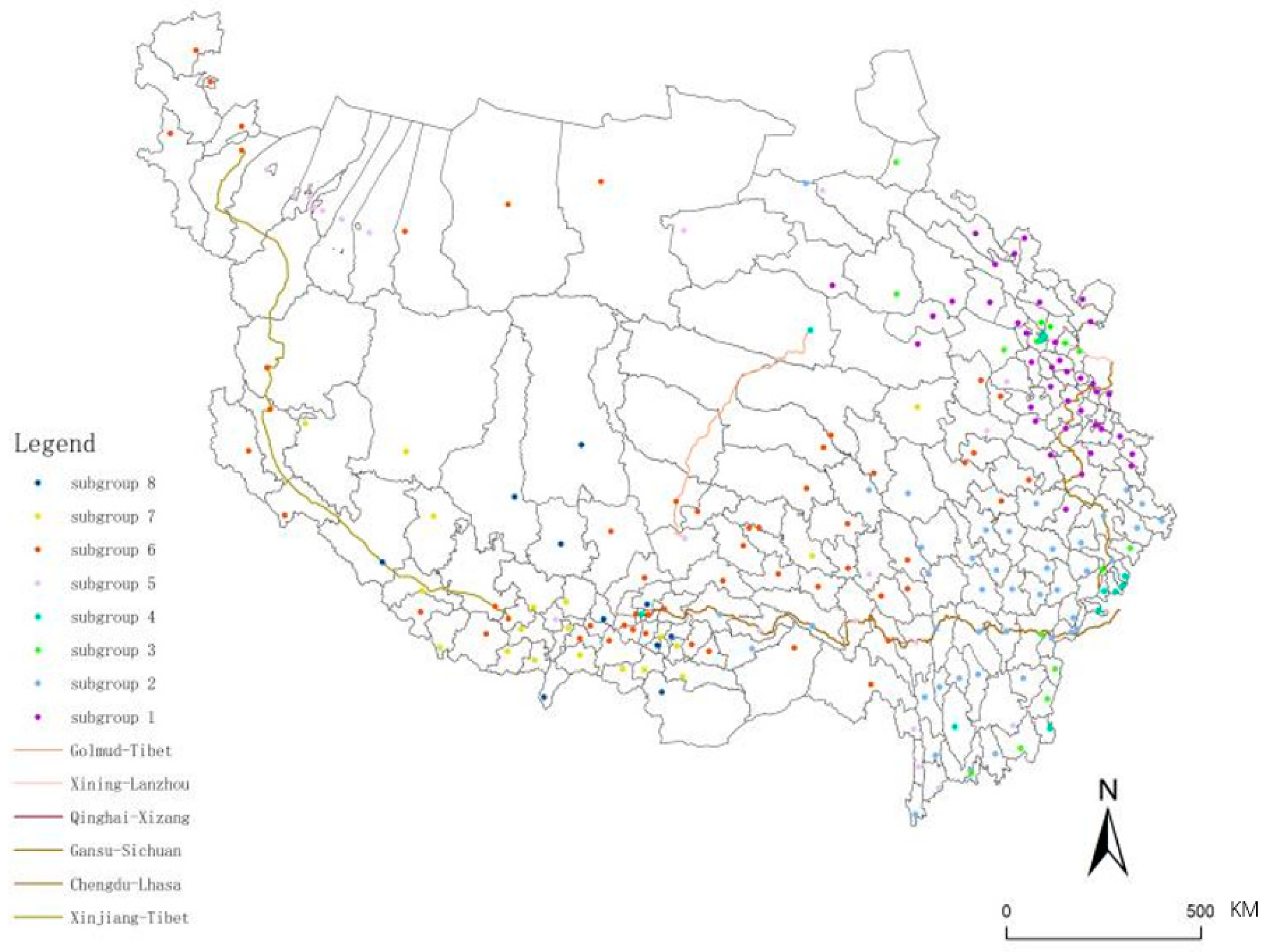
| Indicators | Formula | Explanation of the Formula | Indicator Meaning |
|---|---|---|---|
| Tourism economic linkage intensity | Rij is the intensity of tourism linkage of region i and j; Pi and Pj are the tourism receptions of region i and j; Vi and Vj are the tourism revenues of region i and j; dij is the actual shortest road distance between region i and j; g is the regional gross product. Dij indicates the economic distance between region i and j, which is calculated by dij/gi − gj; considering there is a difference between the tourism linkage and the pure economic attraction of the two regions, through Vi/Vi + Vj to calculate the correction coefficient Kij, to reflect the weight of region i to region j tourism linkage strength. | The larger the value of Rij, the stronger the tourism linkage between regions i and j and the more active the tourism interaction. | |
| Degree Centrality | CD(ni) denotes the degree centrality of region i; d(ni) denotes the number of effective links between region i and other node regions; g denotes the number of all regions in this network. | CD characterizes the agglomeration-diffusion structure of the network. This indicator portrays the central nodes with substantial influence and diffusion power in the social network. It is used to measure the importance of the position of a county in the overall regional tourism development.There are out-degree and in-degree in the directed network matrix; out-degree indicates the attraction of one spatial unit to another spatial unit and represents the agglomeration of space; in-degree indicates the attraction of one spatial unit to another spatial unit and represents the radiation of space [63]. | |
| Betweenness centrality | j≠k; CB(ni) denotes the betweenness centrality of region i; gjk(ni) denotes the number of shortcuts with region i on the shortcut for region j to reach region k; gjk denotes the number of shortcuts for region j to reach region k; g is the total number of regions in this overall regional network. | CB characterizes the dynamic capacity structure of the network. This indicator portrays the central node in the social network with a high intermediary capacity to measure the ability of a county to control tourism interactions with the other two counties and is an important dynamic parameter that influences network changes. | |
| Total number of tourism links | Ti is the total number of tourism links in region i. | Ti characterizes the structural features of the organizational capacity of the network. This indicator is the sum of the intensity of tourism linkages in a county, and the larger the value of Ti, the stronger the sharing capacity, which is used to measure the tourism organizational capacity. | |
| Network Density | D is the network density value; m is the actual number of relationships; n is the theoretical maximum number of relationships. | D characterizes the overall cohesiveness of the network. This index portrays the overall network perfection and the tightness of connections between nodes. The larger the D value, the stronger the overall cohesion of the network. |
| Strong Links (pcs) (≥0.6) | Sub-Strong Links (pcs) (<0.6, ≥0.3) | Weak Links (pcs) (<0.3) | Coupling Links (pcs) (Mutual Dominant Flow) | Average Degree of Dominant Flow | |
|---|---|---|---|---|---|
| Tourism flow | 26 (12.15%) | 97 (45.33%) | 91 (42.52%) | 9 (4.2%) | 0.377 |
| Community Structure | Cohesive Subgroup | Main Location (Subgroup Name) | Number of Levels (Strong Center/Sub-strong Center/Medium Strong Center/Subordinate Counties) | Mean Value of Total Tourism Links | Typical Counties |
|---|---|---|---|---|---|
| Eastern Growth Hinterland Group | 1 | Gansu-Qinghai Grand Loop | 0/2/10/27 | 17 | Ping’an 1, Guide 3, Huangyuan 1, Haiyan 1, Jianzha 1, Hongyuan 1 |
| 2 | Shangri-La Grand Loop | 0/7/13/23 | 39.8 | Gucheng 1, Li 3, Daocheng 3, Qingchuan 3, Mao 3, Lushan 3 | |
| Eastern Growth Group | 3 | Ring of Growth Poles Group | 0/8/5/2 | 130.33 | Wenchuan 3, Yulong Naxi 4, Mianning 3, Beichuan Qiang 4, Huangzhong 1, Shimian 3 |
| 4 | Growth Pole Group | 6/5/2/0 | 1549.57 | Chengxi 1, Chengbei 1, Chengdong 1, Pengzhou 2, Dujiangyan 2, Chengzhong 1, Xichang 2 | |
| Northwest Group | 5 | Northern Group | 0/0/0/21 | 1.63 | Mangya 3, Hetian 3, Luopu 3, Kunyu 2, Yutian 3, Pishan 3, Cele 3 |
| 6 | Qinghai-Tibet-Xinjiang Loop | 0/1/1/53 | 5.32 | Duilongdeqing 1, Dazi 1, Mozhugongka 3, Gonga 3, Qushui 3, Dangxiong 3 | |
| Tibetan Group | 7 | Ali Grand Loop | 0/0/0/19 | 0.07 | Naidong 1, Bailang 3, Qusong 3, Nanmulin 3, Xietongmen 3, Sajia 3 |
| 8 | Tibet mini-loop | 0/0/0/10 | 0.545 | Linzhou 3, Nimu 3, Sangri 3, Qiongjie 3, Yadong 3, Cuona 3 |
Publisher’s Note: MDPI stays neutral with regard to jurisdictional claims in published maps and institutional affiliations. |
© 2022 by the authors. Licensee MDPI, Basel, Switzerland. This article is an open access article distributed under the terms and conditions of the Creative Commons Attribution (CC BY) license (https://creativecommons.org/licenses/by/4.0/).
Share and Cite
Shi, S.; Liu, M.; Xi, J. Hierarchical Structure and Organizational Model of County Tourism Network of the Tibetan Plateau. Land 2022, 11, 1880. https://doi.org/10.3390/land11111880
Shi S, Liu M, Xi J. Hierarchical Structure and Organizational Model of County Tourism Network of the Tibetan Plateau. Land. 2022; 11(11):1880. https://doi.org/10.3390/land11111880
Chicago/Turabian StyleShi, Shanshan, Menghao Liu, and Jianchao Xi. 2022. "Hierarchical Structure and Organizational Model of County Tourism Network of the Tibetan Plateau" Land 11, no. 11: 1880. https://doi.org/10.3390/land11111880
APA StyleShi, S., Liu, M., & Xi, J. (2022). Hierarchical Structure and Organizational Model of County Tourism Network of the Tibetan Plateau. Land, 11(11), 1880. https://doi.org/10.3390/land11111880








